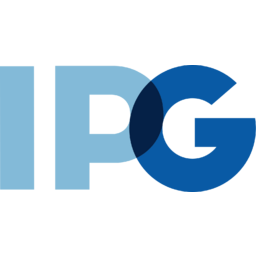
P/E ratio for Interpublic Group (IPG)
P/E ratio as of April 2024 (TTM): 12.9
According to Interpublic Group's latest financial reports and stock price the company's current price-to-earnings ratio (TTM) is 12.9218. At the end of 2022 the company had a P/E ratio of 13.9.
P/E ratio history for Interpublic Group from 2001 to 2023
PE ratio at the end of each year
| Year | P/E ratio | Change |
|---|---|---|
| 2022 | 13.9 | -9.94% |
| 2021 | 15.5 | -40.78% |
| 2020 | 26.1 | 92.32% |
| 2019 | 13.6 | 6.04% |
| 2018 | 12.8 | 1.06% |
| 2017 | 12.7 | -17.13% |
| 2016 | 15.3 | -26.02% |
| 2015 | 20.7 | 14.51% |
| 2014 | 18.1 | -37.76% |
| 2013 | 29.0 | 168.57% |
| 2012 | 10.8 | 24.36% |
| 2011 | 8.69 | -53.37% |
| 2010 | 18.6 | -49.51% |
| 2009 | 36.9 | 431.14% |
| 2008 | 6.95 | -76.01% |
| 2007 | 29.0 | -149.69% |
| 2006 | -58.3 | 310.72% |
| 2005 | -14.2 | 41.91% |
| 2004 | -10.0 | -10.26% |
| 2003 | -11.1 | -105.54% |
| 2002 | 201 | -1230.32% |
| 2001 | -17.8 |
P/E ratio for similar companies or competitors
| Company | P/E ratio | P/E ratio differencediff. | Country |
|---|---|---|---|
 Alliance Data
ADS | N/A | N/A | 🇺🇸 USA |
 eBay EBAY | 20.6 | 59.07% | 🇺🇸 USA |
 Omnicom OMC | 13.8 | 6.72% | 🇺🇸 USA |
 MDC Partners
MDCA | N/A | N/A | 🇺🇸 USA |
 Lamar Advertising LAMR | 28.2 | 117.95% | 🇺🇸 USA |
 National CineMedia NCMI | N/A | N/A | 🇺🇸 USA |
How to read a P/E ratio?
The Price/Earnings ratio measures the relationship between a company's stock price and its earnings per share. A low but positive P/E ratio stands for a company that is generating high earnings compared to its current valuation and might be undervalued. A company with a high negative (near 0) P/E ratio stands for a company that is generating heavy losses compared to its current valuation.
Companies with a P/E ratio over 30 or a negative one are generaly seen as "growth stocks" meaning that investors typically expect the company to grow or to become profitable in the future.
Companies with a positive P/E ratio bellow 10 are generally seen as "value stocks" meaning that the company is already very profitable and unlikely to strong growth in the future.